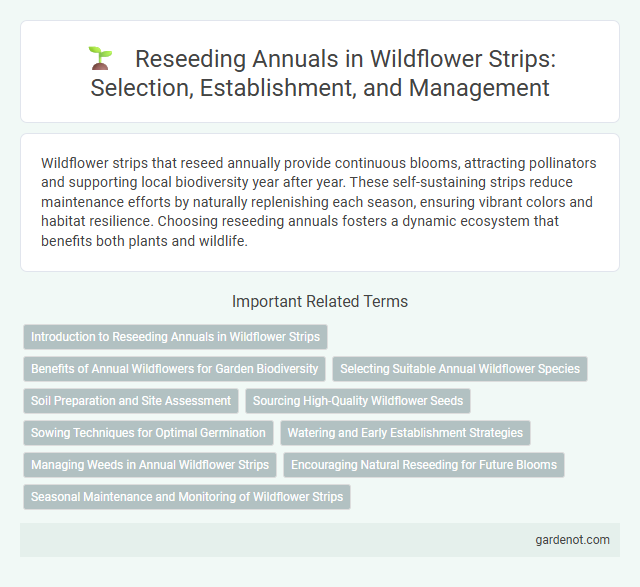Wildflower strips that reseed annually provide continuous blooms, attracting pollinators and supporting local biodiversity year after year. These self-sustaining strips reduce maintenance efforts by naturally replenishing each season, ensuring vibrant colors and habitat resilience. Choosing reseeding annuals fosters a dynamic ecosystem that benefits both plants and wildlife.
Introduction to Reseeding Annuals in Wildflower Strips
Reseeding annuals in wildflower strips play a crucial role in maintaining vibrant biodiversity and continuous bloom throughout growing seasons. These species self-sow each year, ensuring natural regeneration and reducing the need for manual reseeding efforts. By supporting pollinators such as bees and butterflies, reseeding annuals contribute to ecosystem health and promote sustainable agricultural landscapes.
Benefits of Annual Wildflowers for Garden Biodiversity
Reseeding annual wildflowers enhance garden biodiversity by attracting a wide range of pollinators such as bees, butterflies, and hoverflies, which support ecosystem health. These wildflowers provide essential nectar and pollen sources throughout the growing season, promoting the survival of beneficial insects and birds. Their rapid growth and reseeding nature ensure continuous habitat renewal, improving soil health and increasing plant diversity in garden ecosystems.
Selecting Suitable Annual Wildflower Species
Selecting suitable annual wildflower species for reseeding wildflower strips requires evaluating local climate conditions and soil type to ensure optimal germination and growth. Species such as California poppy, cosmos, and black-eyed Susan are commonly favored for their adaptability, vibrant blooms, and ability to support pollinators. Prioritizing native annuals enhances biodiversity and helps maintain ecological balance within the reseeded wildflower strip.
Soil Preparation and Site Assessment
Reseeding annual wildflower strips requires thorough soil preparation, including loosening the topsoil to improve seed-to-soil contact and ensuring proper drainage to prevent waterlogging. Site assessment should evaluate soil pH, nutrient levels, and existing vegetation to select suitable wildflower species that thrive in the specific environmental conditions. Proper timing of reseeding, typically in early spring or fall, maximizes germination success and long-term strip vitality.
Sourcing High-Quality Wildflower Seeds
Sourcing high-quality wildflower seeds for reseeding annual wildflower strips ensures robust germination and vibrant bloom cycles, promoting biodiversity and pollinator habitats. Selecting seeds from reputable suppliers who provide region-specific, native species enhances ecological compatibility and soil adaptation. Utilizing certified, untreated seeds reduces the risk of introducing invasive plants and supports sustainable ecosystem restoration efforts.
Sowing Techniques for Optimal Germination
For optimal germination in reseeding annual wildflower strips, prepare the soil by lightly tilling to create a fine seedbed that improves seed-to-soil contact. Broadcast seeds evenly and cover them with a thin layer of soil, no more than twice the seed's diameter, to maintain moisture and protect from birds. Consistent moisture through irrigation or natural rainfall during the germination phase is crucial for successful seedling establishment.
Watering and Early Establishment Strategies
Reseeding annual wildflower strips requires consistent watering to ensure seed germination and robust early growth, ideally providing 1 inch of water per week. Mulching around seeded areas helps retain soil moisture and temperature, promoting quicker seedling emergence and establishment. Early establishment strategies include soil preparation with light tilling and avoiding competition from weeds through timely mowing or herbicide applications.
Managing Weeds in Annual Wildflower Strips
Reseeding annual wildflower strips requires effective weed management strategies to ensure optimal plant growth and biodiversity. Regular monitoring and timely removal of invasive weeds prevent competition for nutrients, water, and light, promoting healthy wildflower development. Employing techniques such as targeted herbicide use, soil disturbance control, and mulching improves reseeding success and maintains the ecological balance within the strip.
Encouraging Natural Reseeding for Future Blooms
Encouraging natural reseeding in wildflower strips enhances biodiversity by allowing annual species like poppies, cornflowers, and cosmos to regenerate seasonally without replanting. Leaving some seed heads intact and reducing disturbance creates optimal conditions for seed dispersal and germination, promoting sustainable, vibrant blooms year after year. This method supports pollinator populations and reduces maintenance costs while maintaining ecological balance in the wildflower habitat.
Seasonal Maintenance and Monitoring of Wildflower Strips
Reseeding annual wildflower strips ensures vibrant floral diversity and supports pollinator health through consistent seasonal maintenance. Regular monitoring identifies areas of poor germination or invasive species, enabling timely intervention to maintain ecological balance. Seasonal tasks include soil preparation, seed distribution, and targeted watering to optimize growth and sustain habitat quality.
Reseeding annual Infographic

 gardenot.com
gardenot.com